17 December 2006
The closing of the greenhouse door
Laelia tenebrosa. Big, colourful, bold as brass (literally). The flowers measure 18 cm from petal tip to petal tip. It's a summer-flowering Brazilian species and so always flowers around Chrimbo time in the southern hemisphere. Merry Christmas.
An ode to zingerone
 Ginger. Where else would you find a flavour so common-place and familiar, so comfortingly domestic: our house filled with the tempting scent of my mother’s ginger snaps cooling in the kitchen; the deceptively light ginger beer we used to make during the summer school holidays; Mrs SJE de Villiers’s ginger waffles. Ginger. Where else would you find a flavour so exotically tropical, so wonderfully dangerous, so intertwined with tales of adventure in foreign climes, with the enigmatic history of the Spice Route? Thai curry is nothing without the tang of freshly grated ginger, sushi is just fish pressed between some rice without the delightful pink arrangement of amazu shoga to cleanse and refresh the palate in between bites.
Ginger. Where else would you find a flavour so common-place and familiar, so comfortingly domestic: our house filled with the tempting scent of my mother’s ginger snaps cooling in the kitchen; the deceptively light ginger beer we used to make during the summer school holidays; Mrs SJE de Villiers’s ginger waffles. Ginger. Where else would you find a flavour so exotically tropical, so wonderfully dangerous, so intertwined with tales of adventure in foreign climes, with the enigmatic history of the Spice Route? Thai curry is nothing without the tang of freshly grated ginger, sushi is just fish pressed between some rice without the delightful pink arrangement of amazu shoga to cleanse and refresh the palate in between bites. Oh, how I long for a colonial home: trade winds kicking up sand outside the screen doors, the texture of damask table linen, ceiling fans uselessly circulating the oppressive heat, the sound of singing coming from the plantation and Ceylon tea served at exactly four o’clock in fine white china with – best of all – some golden pieces of crystallized ginger! Ginger. The essence of contradiction. A taste of latent ruin.
Ginger is the rhizome of Zingiber officinale. The word ‘ginger’ is derived from the Sanskrit word shringavera, which means ‘shaped like a deer’s antlers’. The Zingiberaceae family possesses other culinary delights: Curcuma longa is a closely related plant and the source of the spice turmeric. The hot, pungent molecule in ginger is called zingerone. A name suited to a forbidden aphrodisiac. Chemically, it looks a lot like capsaicin, the hot molecule found in chillies, but lacks the long hydrocarbon tail and a nitrogen atom. It fits pain receptors on the tongue. A sting of pleasure. The ginger rhizome holds a complex variety of related compounds, all differing just slightly from zingerone in the length of the chain replacing one of the hydrogen atoms of the terminal methyl group. The exact blend of this intricate set of aromatics depends on nutrients in the soil, the temperature, the availability of light and a myriad of other growing conditions, making each piece of ginger totally unique.
Common ginger has small white and maroon flowers, but many of the other 60 Zingiber species and many related plants in the Zingiberaceae family have curiously beautiful, sometimes almost orchid-like blossoms: check out Zingiber spectabile, Roscoea purpurea, Costus pulverulentus, Etlingera eliator, and Hedychium coccineum at your nearest tropical conservatory. I never cease to be inspired and enchanted by the versatility of ginger. Here are two very easy recipes I’ve come across in my infatuation with ginger, my zingerone addiction.
Gingered watermelon juice
500 g watermelon, peeled, de-seeded and roughly chopped
2 tsp ginger, freshly grated
Process ingredients in a blender or food processor for 2 minutes. Add 6 ice cubes and process until ice is crushed. Serve garnished with a thin wedge of watermelon.
Gingery lemon muffins
1/4 cup maragrine, room temperature
1/4 cup sugar
1 egg
2 tbsp ginger, peeled and coarsely chopped
2 tbsp grated lemon zest
1 tsp baking soda
1 1/2 cups plain, low-fat yoghurt or buttermilk
2 cups plain flour
Cream together margarine and sugar in a large bowl. Beat in egg. Add ginger and lemon zest. In a separate small bowl, stir baking soda into buttermilk; it will start to bubble and rise. Fold flour into ginger mixture one third at a time, alternating with buttermilk. When well blended, spoon into greased muffin pans. Bake in a preheated 190°C oven for 15-20 minutes, or until lightly browned.
7 December 2006
5 things to do before 2006 ends
2. Make a glass tile mosaic. This has become a December tradition.
3. Repot all of the neglected orchids which are now taking root outside their pots. I'm a bad mother, sniff.
4. Read something longer than 100 pages that does not concern photosynthesis, kinase signal transduction or UDP:glucosyltransferase enzymes.
5. Lose some weight. Hmmm. This one might prove problematic right before the season of honey-glazed everything.
24 November 2006
Post # 50
I give my final talk in the Genetics Department today, as part of our annual postgraduate symposium. I kind of enjoy giving everyone a comprehensive overview of my research. It does look like there was a point to all of the suffering after all. Apparently the Fulbright people are negotiating my tuition fees with the people at Colorado State, so that looks like it's becoming a reality. Lunch is served outside, in the FABI courtyard by the koi pond. Lasagne and a fresh garden salad. Prepared by the same people who normally do the yucky food for the residences. Who knew they had it in them?
I am indescribably tired, but you know what? It's been a good week.
18 November 2006
It never rains
10 November 2006
An update, of sorts
I apologize for the lack of activity on this blog, but every once and again, life happens to the author and other things do take preference over Eclectic Epiphytes, I'm afraid. I planned a big, final In The Greenhouse post for October to celebrate a full year of orchids, but this has been delayed. As I'm not at varsity much these days (it's where I upload the photographs), you fans of horticultural things will just have to bear with me that bit longer.
Last weekend was, erm... interesting, to say the least. As you know, I've been jumping through the hoops for the Fulbright people, in order to have some sort of career, eventually. One of the pieces of admin is passing something called the GRE Subject Test in Biochemistry, Cell and Molecular Biology. For reasons that escape me, I somehow failed to be registered for the 4 November test in time. This meant going onto something called "standby registration", which means popping over to the test centre on the morning of the test and asking the benevolent administrators to literally "squeeze you in". So on the morning of 4 November 2006, after having studied the components of the Krebs cycle and the intricacies of the lac operon for two days straight, I drive all the way to Wits, or as Wendy likes to call it, the Alcatraz of South African universities. After going through several rounds of close scrutiny by security guards and scary receptionists behind bullet proof glass, I'm led to the basement level of a building called the Senate House. (To my ears the security personnel kept calling it the Sears Tower, which I'm convinced is in Chicago.) Upon descending the wooden staircase to the basement level, I find several nervous persons fidgeting on a little bench. I had - literally - descended into madness. The two test administrator's were probably retired schoolteachers or something (I seem to recall them carrying the exam papers in a little cloth covered basket). In my mind however, they turn into the two psycho old people who crawled out of the brown paper bag at the end of Mulholland Drive
So now I can only write the damn test next year April. When will this mad world of bureaucracy ever end? Later that afternoon, I drove 265km to a game farm near Thabazimbi, where I spent our annual lab "workshop" in a drunken state of ennui.
And you?
PS: I apologize for my excessive use of quotation marks, but it's the mood I'm in, you see.
12 October 2006
Degrees of Separation
Each piece of music is connected to every other piece of music, just as all actor's are connected to one another in the Kevin Bacon Game. All music is connected, and not just through shared influences, shared recording studios and such. I like knowing that all of the music in my collection is made by this network of musicians and technicians, this family of artists. My family, somehow. Just for fun, let me list some connections, off the top of my head. No sleeve notes, no Googling.
Let's start with Goldfrapp. Alison Goldfrapp performed vocals on Tricky's debut album, Maxinquaye. Tricky used to be a member of Massive Attack. Massive Attack did the arrangements for I Want You on Madonna's collection of ballads, Something To Remember
0 minutes, 20 seconds. Gotta go.
8 October 2006
Tag, I'm it
One. Everyone seems to start with this one. I was born in the Mary Font Hospital, Pretoria, on the 1st April 1981 by caesarian section. Yes, and I do get the April Fool thing every year, folks!
Two. Dexter-sinister factoids: I'm left-handed, but use scissors made for right-handed people. I wear one contact lens, in my left eye, to correct short-sightedness. The right eye has perfect vision.
Three. Seeing Depeche Mode in concert
Four. In 1989 I fell down part of the waterfall at Klein Kariba. That was the day I broke my left leg (see point two).
Five. Kate Atkinson is my favourite author. I'm dying to read her new novel, One Good Turn
Six. I like going to movies on my own, but definitely feel uncomfortable sitting in restaurants alone. Maybe it's because I don't smoke? What do you do with your hands?
Seven. Christmas makes me melancholy. Easter is a much more guilt-free religious holiday (it's kind of the point of Easter, isn't it?).
Eight. In 1997 I was presented with a HAT by Prof. Elize Botha for being the overall winner of the Afrikaans Expo. The following year, one of my poems was read aloud at the award ceremony by Jannie du Toit. These were proud moments for me.
Nine. I dislike passionless people and zealous extremists in equal measure. But I think I hate bureaucrats most of all.
Ten. I lived in Pietermaritzburg from 1989 to 1993 and have fond memories of biking around the Ferncliffe Nature Reserve and the Sappi plantations.
Eleven. I received a Fulbright scholarship to pursue a PhD in the USA in 2007.
Twelve. I cannot stand gem squash.
Thirteen. I'm a closet fan of romantic comedies.
Fourteen. The longest I managed to stop biting my nails is 4 weeks.
Fifteen. People are always surprised by my athleticism. Sports make me tense because I'm competitive and I hate feeling hot and sweaty; that's why I'm not that active. Not because I can't do it, it's that I don't like to feel tense and bothered.
Sixteen. I'm pro-choice, but think each case has its own merit and needs to go through a commitee review process first.
Seventeen. I tend to switch off when boring people talk to me, then snap back and realize that I have absolutely no idea of what they're on about. Bad habit or sanity preservation strategy? Methinks the latter.
Eighteen. My favourite record is Songs of Faith and Devotion
Nineteen. Ten thousand six hundred and forty-five is the amount of words so far completed for a humorous novel I started writing in 2000, but now know I'll probably never finish.
Twenty. I'm an obsessive-compulsive hypochondriac. But a sensible one.
2 October 2006
5 things I plan on doing (but secretly know I never will)
2. Learn to speak an African language.
3. Read a Jane Austen novel.
4. Learn to play the guitar.
5. Repot all the orchids in a single marathon weekend session.
*Sigh*
24 September 2006
We're one, but we're not the same
The other day, in my old copy of The Book of Lists,
Why don't you talk to me now?
Oh my mother
Do you still cry yourself to sleep?
Are you still proud of your little boy?
More questions than answers. In 1996, Pet Shop Boys released Bilingual,
Every straight man's favourite fag, Freddy Mercury, was possessed by the act of perfecting the multi-layered masterpiece Bohemian Rhapsody for Queen's remarkable 1975 album A Night at the Opera.
The most common interpretation of the lyrical content of One, taken from the 1991 U2 album Achtung Baby,
Or leave a bad taste in your mouth?
You act like you never had love
And you want me to go without
More questions again. Confessors waiting for a response. This time, will it be judgement or compassion?
18 September 2006
Once Upon a Time
1. The Bridge of San Luis Rey - Thornton Wilder [1927]
"On Friday noon, July the twentieth, 1714, the finest bridge in all Peru broke and precipitated five travellers into the gulf below."
2. Cold Comfort Farm - Stella Gibbons [1932]
"The education bestowed on Flora Poste by her parents had been expensive, athletic and prolonged; and when they died within a few weeks of one another during the annual epidemic of the influenza or Spanish Plague which occured in her twentieth year, she was discovered to possess every art and grace save that of earning her own living."
3. The Outsider - Albert Camus [1942]
"Mother died today. Or maybe yesterday, I don't know."
4. The Master and Margarita - Mikhail Bulgakov [1967]
"At the hour of the hot spring sunset two citizens appeared at the Patriach's Ponds."
5. One Hundred Years of Solitude - Gabriel García Márquez [1967]
"Many years later, as he faced the firing squad, Colonel Aureliano Buendía was to remember that distant afternoon when his father took him to discover ice."
6. Tales of the City - Armistead Maupin [1980]
"Mary Ann Singleton was twenty-five years old when she saw San Francisco for the first time."
7. Less Than Zero - Bret Easton Ellis [1985]
"People are afraid to merge on freeways in Los Angeles."
8. The Object of My Affection - Stephen McCauley [1987]
"Nina and I had been living together in Brooklyn for over a year when she came home one afternoon, announced she was pregnant, tossed her briefcase to the floor and flopped down on the green vinyl sofa."
9. A Home at the End of the World - Michael Cunningham [1990]
"Once our father bought a convertible. Don't ask me. I was five."
10. The Secret History - Donna Tartt [1992]
"The snow in the mountains was melting and Bunny had been dead for several weeks before we came to understand the gravity of our situation."
11. A Map of the World - Jane Hamilton [1994]
"I used to think if you fell from grace it was more likely than not the result of one stupendous error, or else an unfortunate accident. I hadn't learned that it can happen so gradually you don't lose your stomach or hurt yourself in the landing."
12. The Dead Heart - Douglas Kennedy [1994]
"I had never seen so many tattoos."
13. Midnight in the Garden of Good and Evil - John Berendt [1994]
"He was tall, about fifty, with darkly handsome, almost sinister features: a neatly trimmed mustache, hair turning silver at the temples, an eyes so black they were like the tinted windows of a sleek limousine - he could see out, but you couldn't see in."
14. Fight Club - Chuck Palahniuk [1996]
"Tyler gets me a jo as a waiter,after that Tyler's pushing a gun in my mouth and saying, the first step to eternal life is you have to die."
15. The House of Sleep - Jonathan Coe [1997]
"It was their final quarrel, that much was clear."
16. Devil's Valley - André P. Brink [1998]
"'I been sitting here, waiting for you,' said the old man, not bothering to look at me."
17. Coast - Matthew Branton [2000]
"It started the day the Indian boys fell out of the sky."
18. Emotionally Weird - Kate Atkinson [2000]
"My mother is a virgin. (Trust me.)"
19. Orchid Fever - Eric Hansen [2000]
"There is something distinctive about the sight and sound of a human body falling from the rain forest canopy."
20. Middlesex - Jeffrey Eugenides [2002]
"I was born twice: first, as a baby girl, on a remarkably smogless Detroit day in January 1960; and then again, as a teenage boy, in an emergency room near Petoskey, Michigan, in August of 1974."
11 September 2006
Generally Redundant Examination
Empire Road is the home of the Thomson Prometric office, where I had to take a GRE test. The GRE test being one of the requirements of the Fulbright Commission, even though I have a BSc(Hons) degree in the field of molecular biology and will hopefully have an MSc degree soon, too. Luckily the Fulbright people at the US Embassy gave me a voucher, so I got to take the test for free. This test measures your language and basic mathematical skills. In the end I felt like I had driven 120 kilometres and spent a whole day proving something that I felt could be ascertained by reviewing my tertiary education history. What a waste. We are all slaves to bureaucracy and there's nothing we can do about it. Or is there?
1 September 2006
In The Greenhouse (09/06)
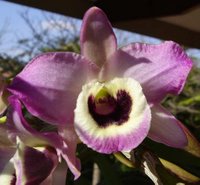 Dendrobium nobile 'Joyful Heart'. I purchased this Himalayan plant for R50,00 from MC Orchids several years ago. Then, it was a cute little ikebana of a plant, with a couple of spindly canes with velvety pink flowers on them. Since then, it has grown into a splendid specimen plant, a monster that entirely covers the large coconut-fibre basket it grows in. I completely stop watering it by the end of May, when its resting period commences. All the leaves from the previous season's growth drop off, leaving the canes completely bare. By the end of July, tiny buds start to form at the nodes of the bare canes. These develop into gorgeous trusses of flowers like the one you see here. My favourite is the inviting, dark velvety centre and the dangerously spicy scent. Furry.
Dendrobium nobile 'Joyful Heart'. I purchased this Himalayan plant for R50,00 from MC Orchids several years ago. Then, it was a cute little ikebana of a plant, with a couple of spindly canes with velvety pink flowers on them. Since then, it has grown into a splendid specimen plant, a monster that entirely covers the large coconut-fibre basket it grows in. I completely stop watering it by the end of May, when its resting period commences. All the leaves from the previous season's growth drop off, leaving the canes completely bare. By the end of July, tiny buds start to form at the nodes of the bare canes. These develop into gorgeous trusses of flowers like the one you see here. My favourite is the inviting, dark velvety centre and the dangerously spicy scent. Furry.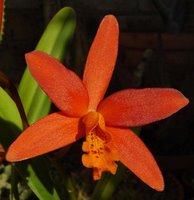 Laeliocattleya Trick or Treat. How delicious is this? Bright vermillion, starry flowers are completely irresistable and there are many similar Laeliocattleyas to choose from. Lc. Trick or Treat is one of the best and most famous of these miniature jewels and was hybridised in the 1970's by the experts at Stewart Orchids. Zesty.
Laeliocattleya Trick or Treat. How delicious is this? Bright vermillion, starry flowers are completely irresistable and there are many similar Laeliocattleyas to choose from. Lc. Trick or Treat is one of the best and most famous of these miniature jewels and was hybridised in the 1970's by the experts at Stewart Orchids. Zesty.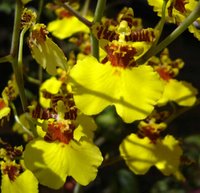 Oncidium hybrid. Karen Little gave this plant to me for my birthday about two years ago. The tag listed it as Oncidium flexuosum, which it definitely is not. The size and shape of the pseudobulbs is completely different, not to mention the patterning on the flowers. It's very possible that Onc. flexuosum features somewhere in this plant's parentage, but without a proper tag, it is impossible to be certain. Whatever the exact genetic make up, this is a superior plant with a large (almost 1m tall!) and branching inflorescence carrying hundreds of perfectly formed yellow flowers with red and brown markings. It grows outside in bright but filtered sunlight, receiving lots of water and fresh air. I love it. Bright.
Oncidium hybrid. Karen Little gave this plant to me for my birthday about two years ago. The tag listed it as Oncidium flexuosum, which it definitely is not. The size and shape of the pseudobulbs is completely different, not to mention the patterning on the flowers. It's very possible that Onc. flexuosum features somewhere in this plant's parentage, but without a proper tag, it is impossible to be certain. Whatever the exact genetic make up, this is a superior plant with a large (almost 1m tall!) and branching inflorescence carrying hundreds of perfectly formed yellow flowers with red and brown markings. It grows outside in bright but filtered sunlight, receiving lots of water and fresh air. I love it. Bright. Cymbidium hybrid. This is an orphan I inherited from my aunt when she moved to George. It had a name tag nestled in the potting mix, but it was too eroded to be read. I repotted the plant immediately, dividing it and placing my divisions in terracotta pots filled with large chunks of composted pine bark. This year, the divisions each made two spikes of graceful jade blooms with intricately patterned lips. Graceful.
Cymbidium hybrid. This is an orphan I inherited from my aunt when she moved to George. It had a name tag nestled in the potting mix, but it was too eroded to be read. I repotted the plant immediately, dividing it and placing my divisions in terracotta pots filled with large chunks of composted pine bark. This year, the divisions each made two spikes of graceful jade blooms with intricately patterned lips. Graceful. Masdevallia Copper Angel 'Highlands'. Masdevallias are rude and obscene harlots. They appeal to the senses with their perfect symmetry and curiously glowing colours, luring you into the very centre of the flower where the reproductive parts are hiding, like a dirty secret. They are impossible to photograph accurately. This one is a primary cross between Masd. triangularis and Masd. veitchiana. It is a deep orange colour, with dark burgundy hairs all over this orange base, giving the impression of a luminescent sheen that moves over the surface as it bobs in the breeze. Fluorescent.
Masdevallia Copper Angel 'Highlands'. Masdevallias are rude and obscene harlots. They appeal to the senses with their perfect symmetry and curiously glowing colours, luring you into the very centre of the flower where the reproductive parts are hiding, like a dirty secret. They are impossible to photograph accurately. This one is a primary cross between Masd. triangularis and Masd. veitchiana. It is a deep orange colour, with dark burgundy hairs all over this orange base, giving the impression of a luminescent sheen that moves over the surface as it bobs in the breeze. Fluorescent.  Rhyncholaelia glauca. Yummy. This is sometimes known as Brassavola glauca, but is actually quite different from individuals in that genus. This species is found in open hot forests in Central America. It is glaucous, the leaves having a waxy blue appearance. Single 12cm flowers are produced from the newest pseudobulbs. Drying out between waterings is imperative for this species and as you can see, mine is quite happy growing on a log mount. I like the tiny red detail right in the centre of the lip that draws the pollinating insect right into the middle. Would this plant compete for pollinator attention with cactus flowers of similar appearance? Both are white and emit a strong perfume at night and would therefore be visited by moths. I haven't read anything to that effect, but it seems very likely. Pristine.
Rhyncholaelia glauca. Yummy. This is sometimes known as Brassavola glauca, but is actually quite different from individuals in that genus. This species is found in open hot forests in Central America. It is glaucous, the leaves having a waxy blue appearance. Single 12cm flowers are produced from the newest pseudobulbs. Drying out between waterings is imperative for this species and as you can see, mine is quite happy growing on a log mount. I like the tiny red detail right in the centre of the lip that draws the pollinating insect right into the middle. Would this plant compete for pollinator attention with cactus flowers of similar appearance? Both are white and emit a strong perfume at night and would therefore be visited by moths. I haven't read anything to that effect, but it seems very likely. Pristine. Dendrobium kingianum. Possibly the easiest of all orchids to grow. It has a profusion of shapely dusky pink flowers in spring. It is a coastal lithophyte from eastern Australia. There are thousands of named varieties, some with speckles or stripes, some which are pure white and some the colour of a good red wine. Keep it in dappled light, provide an open potting mix and water it once a week. I fertilize mine when I remember (which is seldom) and it seems to do just fine. Really difficult to kill, perhaps a little tricky to grow really well. Use your intuition and your Den. kingianum will reward you. Accommodating.
Dendrobium kingianum. Possibly the easiest of all orchids to grow. It has a profusion of shapely dusky pink flowers in spring. It is a coastal lithophyte from eastern Australia. There are thousands of named varieties, some with speckles or stripes, some which are pure white and some the colour of a good red wine. Keep it in dappled light, provide an open potting mix and water it once a week. I fertilize mine when I remember (which is seldom) and it seems to do just fine. Really difficult to kill, perhaps a little tricky to grow really well. Use your intuition and your Den. kingianum will reward you. Accommodating. Pleurothallis truncata. What a lovely and curious group of orchids the Pleurothallids are. I've read accounts of explorers who entered the deepest parts of Andean cloud forests to find that the dominant vegetation is Pleurothallids, simply covering every dripping surface. There are over 1000 species in the genus Pleurothallis, and many in related genera like Restrepia and Dracula. I purchased this one from Afri-Orchids this year and am quite pleased with it. It is a cool growing native of Ecuador and thrives at high altitudes, where temperatures are constant and rain abundant. Each flower is about a third of a centimetre in diameter. Curious.
Pleurothallis truncata. What a lovely and curious group of orchids the Pleurothallids are. I've read accounts of explorers who entered the deepest parts of Andean cloud forests to find that the dominant vegetation is Pleurothallids, simply covering every dripping surface. There are over 1000 species in the genus Pleurothallis, and many in related genera like Restrepia and Dracula. I purchased this one from Afri-Orchids this year and am quite pleased with it. It is a cool growing native of Ecuador and thrives at high altitudes, where temperatures are constant and rain abundant. Each flower is about a third of a centimetre in diameter. Curious. Oncidium Gower Ramsey. This is supposed to be one of the best Oncidium crosses ever made. It pales in comparison to Karen's lovely no name brand cross above, though. It's pretty standard as modern hybrid Oncidiums go, being nice and compact with a good flower count and lasting power. I've glued some cuttings from it onto a Cordyline in the garden and they seem to handle Highveld epiphytic life very well indeed. The common name for Oncidium is 'Dancing Doll' or 'Dancing Lady' from the way the lip resembles a flamenco dancer's skirt. The scientific name Oncidium, however, refers to the cancer-like growths at the base of the lip (from Greek = onkos, a tumour). Not what you expected, right? Sweet.
Oncidium Gower Ramsey. This is supposed to be one of the best Oncidium crosses ever made. It pales in comparison to Karen's lovely no name brand cross above, though. It's pretty standard as modern hybrid Oncidiums go, being nice and compact with a good flower count and lasting power. I've glued some cuttings from it onto a Cordyline in the garden and they seem to handle Highveld epiphytic life very well indeed. The common name for Oncidium is 'Dancing Doll' or 'Dancing Lady' from the way the lip resembles a flamenco dancer's skirt. The scientific name Oncidium, however, refers to the cancer-like growths at the base of the lip (from Greek = onkos, a tumour). Not what you expected, right? Sweet. 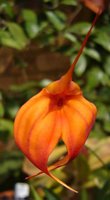 Masdevallia Heathii. An intoxicating flame, this is a cross between Masd. ignea and Masd. veitchiana made, not surprisingly, by Heath at the end of the 19th century. The flowers are large for the size of the dimunitive plant and seem to glow from within. They are carried singly on very long, thin inflorescences and seem disembodied, like will o' the wisps leading you to your demise in the dark places of the old forest. Incendiary.
Masdevallia Heathii. An intoxicating flame, this is a cross between Masd. ignea and Masd. veitchiana made, not surprisingly, by Heath at the end of the 19th century. The flowers are large for the size of the dimunitive plant and seem to glow from within. They are carried singly on very long, thin inflorescences and seem disembodied, like will o' the wisps leading you to your demise in the dark places of the old forest. Incendiary.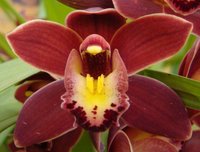 Cymbidium Ivy Fung 'Red Radiance'. This is a very beautiful compact Cymbidium with sex dream dark flowers. It is such a strong grower and flowers very reliably. It will often produce two inflorescences per pseudobulb. My only complaint is that these are really difficult to stake upright, being very rigid. So I just let it run riot, unstaked, with the inflorescences protruding at awkward angles from the base of the pot. Upright inflorescences are a human aesthetic convention at any rate, and not necessarily the natural thing for a specific orchid to produce. Stubborn.
Cymbidium Ivy Fung 'Red Radiance'. This is a very beautiful compact Cymbidium with sex dream dark flowers. It is such a strong grower and flowers very reliably. It will often produce two inflorescences per pseudobulb. My only complaint is that these are really difficult to stake upright, being very rigid. So I just let it run riot, unstaked, with the inflorescences protruding at awkward angles from the base of the pot. Upright inflorescences are a human aesthetic convention at any rate, and not necessarily the natural thing for a specific orchid to produce. Stubborn.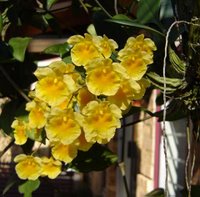 Dendrobium lindleyi. The undeniable star of the season. It is historically known as Den. aggregatum but is now named after the English botanist Lindley. This species hails from the hot jungles of Vietnam and other South East Asian countries. After a dry winter rest, pendulous inflorescences arise from the nodes of the pseudobulbs, quickly producing sulphur yellow flowers with gigantic crystalline lips. A true spring spectacle. Imagine the effort the plant has to go through to produce such exquisite blooms in such profusion. Even a small plant such as mine managed to make four inflorescences. Imagine what a giant specimen in the wild must look like. Now if only it wasn't for all that pesky napalm and Agent Orange stuff... Precious.
Dendrobium lindleyi. The undeniable star of the season. It is historically known as Den. aggregatum but is now named after the English botanist Lindley. This species hails from the hot jungles of Vietnam and other South East Asian countries. After a dry winter rest, pendulous inflorescences arise from the nodes of the pseudobulbs, quickly producing sulphur yellow flowers with gigantic crystalline lips. A true spring spectacle. Imagine the effort the plant has to go through to produce such exquisite blooms in such profusion. Even a small plant such as mine managed to make four inflorescences. Imagine what a giant specimen in the wild must look like. Now if only it wasn't for all that pesky napalm and Agent Orange stuff... Precious.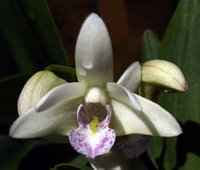 Dendrobium Brengle. A 21st century cross between Den. Glamour and Den. King-Wong. It pretty much resembles Den. x delicatum, which is a natural hybrid between Den. kingianum and Den. speciosum. It packs a lot of Ausie punch into a small package. Similar in gestalt to Den. kingianum, but with shaplier pseudobulbs and bigger flowers, it emits a barely perceptible musky honeyed scent during the early evening. Adjective-hungry.
Dendrobium Brengle. A 21st century cross between Den. Glamour and Den. King-Wong. It pretty much resembles Den. x delicatum, which is a natural hybrid between Den. kingianum and Den. speciosum. It packs a lot of Ausie punch into a small package. Similar in gestalt to Den. kingianum, but with shaplier pseudobulbs and bigger flowers, it emits a barely perceptible musky honeyed scent during the early evening. Adjective-hungry.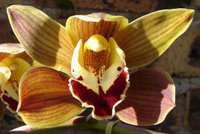 Cymbidium hybrid. Another lovely heirloom. It makes very long inflorescences for a Cymbidium, with the large copper flowers spaced far apart on the descending part of it. It makes a good garden plant, so long as you give it bright light for a large part of the day, and excellent air circulation around the root system. Droopy.
Cymbidium hybrid. Another lovely heirloom. It makes very long inflorescences for a Cymbidium, with the large copper flowers spaced far apart on the descending part of it. It makes a good garden plant, so long as you give it bright light for a large part of the day, and excellent air circulation around the root system. Droopy.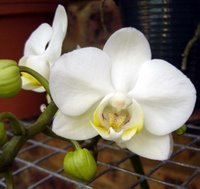 Phalaenopsis Ho's Amaglad. A wonderful cold-tolerant Phalaenopsis. This is the only plant of its kind in my collection not to have lost any leaves during the winter months. It looks like a simple variety of Phal. aphrodite, but actually contains a complex mix of genes from Phal. amabilis, Phal, equestris and Phal. stuartiana. It produces a branching inflorescence with long-lasting, pure white blooms. The yellow detail on the intricate lip is especially striking. Phalaenopsis seem almost tired and overused, like the flavour-of-last-month pot plants of decor and lifestyle magazines. But let me ask you this: how can one ever tire of true beauty? It is timeless. Classic.
Phalaenopsis Ho's Amaglad. A wonderful cold-tolerant Phalaenopsis. This is the only plant of its kind in my collection not to have lost any leaves during the winter months. It looks like a simple variety of Phal. aphrodite, but actually contains a complex mix of genes from Phal. amabilis, Phal, equestris and Phal. stuartiana. It produces a branching inflorescence with long-lasting, pure white blooms. The yellow detail on the intricate lip is especially striking. Phalaenopsis seem almost tired and overused, like the flavour-of-last-month pot plants of decor and lifestyle magazines. But let me ask you this: how can one ever tire of true beauty? It is timeless. Classic. 29 August 2006
Spring Fever
16 August 2006
Top 5 coolest things to do with genetic engineering
1. Ripe and ready to eat. CalGene's Flavr Savr tomato will always have a special place in history. It was the first ever GM food to be approved by the FDA way back in 1994. Normal tomatoes are picked green and hard and then left to ripen in the grocer's cooler. Flavr Savr tomatoes promised juicy vine-ripeness without spoiling during the picking, transportation and storage steps. This exceptional shelf-life worked by silencing the gene responsible for producing ethylene. This gas is produced by ripening fruit, especially bananas and avocados, and keeps the ripening process going. Without the ability to make ethylene, Flavr Savr tomatoes ripen on the vine to a pink blush and then stay in that state until they can be treated with exogenous ethylene right before putting them on display in the store. These GM beauties were last seen on shelves in 1997. Why were they pulled from the market? Not because of any fears about frankenfood, but because they were still picked and transported using traditional hard green tomato methods and equipment. Damage to the soft and squishy Flavr Savr tomatoes was as much as 30% by the time a desperate housewife could lay her hands on one. It was just not economically viable to keep the Flavr Savr going.
2. Got silk? Spider silk has a myriad of potential uses. For a start, it's a really strong protein: stronger than kevlar or reinforced steel, we're told. It's of obvious interest to structural engineers and fashionistas who like their ball gowns bullet proof. But spider silk is a precious commodity and spiders do not cope well with being farmed. Nexia Biotechnology in Quebec Canada has produced transgenic goats that secrete spider silk in their milk. That's right. Just skim it off, stretch, leave to dry, spin into fibres. A visionary technique for mass-producing the fibre of the future.
3. Red alert. The Danish company Aresa has genetically modified the thale cress (Arabidopsis thaliana), a humble weed, to turn a bright red colour when it encounters unexploded land mines underground. This would help alleviate the suffering of people in countries riddled with dormant mines. The explosives slowly release nitrogen dioxide which then causes the leaves of the plant to turn their autumn colours. The genes responsible for producing the red pigment anthocyanin are usually switched off for most of the year, but these scientists have inserted an extra gene that turns on this whole biochemical pathway in the presence of nitrogen dioxide. In true Jurassic Park style, the company has made their patented BioSensor plants dependent on a specific fertilizer mix, so they won't escape into the wild.
4. Something fishy. Certain fish that live in Arctic and Antarctic waters secrete special proteins that protect them from freezing. If such a fish swallows a small ice crystal, these antifreeze glycoproteins bind to it and prevent it from growing larger. Scientists have already produced varieties of potatoes and tomatoes expressing these genes, with the potential to thrive where the dangers of frost would kill lesser crops. But would your salad still be vegetarian?
5. Hot stuff. This is an idea I had in my Honours year for a biotech experiment. Since tomatoes and chillies are in the same plant family, the Solanaceae, they share several characteristics. One feature exclusive to chillies is their burn. This is caused by the capsaicinoid molecules produced by the placenta (the membrane that connects the seeds to the fruit wall). Incidentally, capsaicinoids are produced by chillies to prevent mammals from eating the fruit. The mammalian digestive system destroys chilli seeds, whereas those of birds leave them intact to germinate. Birds do not have the pain receptors sensitive to capsaicinoids and therefore experience no heat rush when feasting on a habanero bush. How cool would it be to transform tomatoes with the genes for the enzymes in the capsaicinoid pathway? It should be a breeze, as the two crops are related. You then get hot tomatoes, useful in relishes and hot salsa. Land used for the production of tomatoes and chillies will be used for growing hot tomatoes with twice the yield. Simple? Not really. The enzymes that produce capsaicinoids haven't all been discovered yet. But if you give me some money, I'll gladly do it for you...
6 August 2006
In The Greenhouse (08/06)
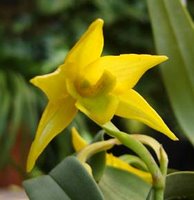 Dendrobium trigonopus. This truly delightful miniature species from South East Asia has bright yellow flowers and an apple green labellum with tiny red striations. It is also part of the Nigrohirsutae group in Dendrobium, which includes beauties like Den. formosum, Den. infundibulum and Den. cruentum. My plant grows mounted on a small piece of timber which is suspended from the roof of the greenhouse in a cool bright aspect. It has a delicious scent that some people say reminds them of honeysuckle. Personally, it reminds me of the smell of a candy shop. Pretty.
Dendrobium trigonopus. This truly delightful miniature species from South East Asia has bright yellow flowers and an apple green labellum with tiny red striations. It is also part of the Nigrohirsutae group in Dendrobium, which includes beauties like Den. formosum, Den. infundibulum and Den. cruentum. My plant grows mounted on a small piece of timber which is suspended from the roof of the greenhouse in a cool bright aspect. It has a delicious scent that some people say reminds them of honeysuckle. Personally, it reminds me of the smell of a candy shop. Pretty.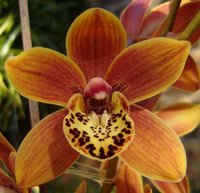 Cymbidium Kusuda Shining. An exceptional modern compact variety. The inflorescence produces the blooms at large intervals for a Cymbidium, displaying them singly and making the whole appearance less cluttered. Bright yellow labellum with prominent dark chocolate markings makes a nice contrast to the rusty amber petals. The column is a darker, dusty rose colour with a light anther cap. Sunny.
Cymbidium Kusuda Shining. An exceptional modern compact variety. The inflorescence produces the blooms at large intervals for a Cymbidium, displaying them singly and making the whole appearance less cluttered. Bright yellow labellum with prominent dark chocolate markings makes a nice contrast to the rusty amber petals. The column is a darker, dusty rose colour with a light anther cap. Sunny. 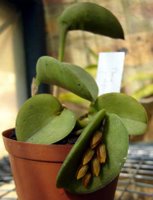 Pleurothallis prolifera. This is a very strange orchid from Venezuela and Brazil. It has coriaceous (i.e. leathery) leaves, quite atypical for its genus and can be found growing lithophytically (that means on rocks, folks) in hot, dry places. Other Pleurothallis are usually found in moist cloud forests, so this one really is the odd one out. Microscopic striped flowers are carried on an inflorescence along the mid-vein of the leaf. Weird.
Pleurothallis prolifera. This is a very strange orchid from Venezuela and Brazil. It has coriaceous (i.e. leathery) leaves, quite atypical for its genus and can be found growing lithophytically (that means on rocks, folks) in hot, dry places. Other Pleurothallis are usually found in moist cloud forests, so this one really is the odd one out. Microscopic striped flowers are carried on an inflorescence along the mid-vein of the leaf. Weird.  Dendrobium Banana Royal. This plants is sometimes listed as Banana Royale. It has a lot of Den. canaliculatum influence and has to be grown in a warm situation with ample light. A dry winter rest is also required for successful flowering. Indeed, I've struggled for the last couple of years to get it to bloom. The flowers are small and twisted and are the colour of just-ripe bananas. Edible.
Dendrobium Banana Royal. This plants is sometimes listed as Banana Royale. It has a lot of Den. canaliculatum influence and has to be grown in a warm situation with ample light. A dry winter rest is also required for successful flowering. Indeed, I've struggled for the last couple of years to get it to bloom. The flowers are small and twisted and are the colour of just-ripe bananas. Edible. 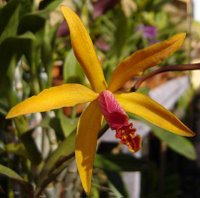 Laeliocattleya Ronselensis. This is a primary hybrid between the dull green Cattleya forbesii and dimunitive orange Laelia cinnabarina. It was first registered in 1904 and again illustrates how the progeny of a cross can be a vast improvement over the parents. This plant carries golden yellow starry flowers with cherry red lips on a tall inflorescence. Perky.
Laeliocattleya Ronselensis. This is a primary hybrid between the dull green Cattleya forbesii and dimunitive orange Laelia cinnabarina. It was first registered in 1904 and again illustrates how the progeny of a cross can be a vast improvement over the parents. This plant carries golden yellow starry flowers with cherry red lips on a tall inflorescence. Perky.


